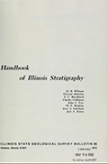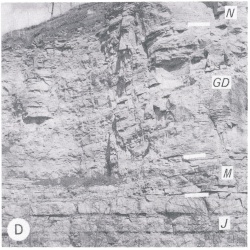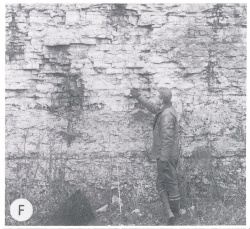Historical:Nachusa Formation
Lithostratigraphy: Ottawa Limestone Megagroup >>Platteville Group >>Plattin Subgroup >>Nachusa Formation
Chronostratigraphy: Paleozoic Erathem >>Ordovician System >>Champlainian Series >>Blackriveran Stage
Allostratigraphy: Tippecanoe Sequence
Authors
H. B. Willman and T. C. Buschbach
Name Origin
The Nachusa Formation (Templeton and Willman, 1963, p. 87), which overlies the Grand Detour Formation, is named for the village of Nachusa, Lee County.
Type Section
The type section is a quarry on the east edge of Dixon (SE SE SW 33, 22N-9E), where the Nachusa is 17.8 feet thick.
Correlation
The Nachusa is correlated with the Chaumont Formation of New York and Ontario because of striking similarities in fauna and lithology, with the upper part of the lower member of the Tyrone Formation in Kentucky, and with the lower member of the Carters Limestone in Tennessee.
Extent and Thickness
The Nachusa is 15-20 feet thick in the northern part of the southern outcrop area, but south of Ste. Genevieve in the Cape Girardeau area it thickens rapidly to 75 feet. It thins to less than 5 feet in subsurface in central western and extreme northwestern Illinois. The Nachusa is absent in the Mississippi Valley northwest of Illinois, but it occurs in northern Michigan.
Description
The Nachusa consists largely of fine- to medium-grained, vuggy dolomite in northern Illinois (fig. O-2F) and dolomite-mottled lithographic limestone in the southern area (fig. O-2D). It is pure to slightly argillaceous, cherty, fucoidal, and thick bedded to massive. The weathered surface is deeply etched. In parts of northern Illinois the Nachusa resembles the dolomite of the Galena Group, and in some areas it has been miscorrelated with the Galena. In the southern outcrop area it contains layers of bentonite, calcarenite, and conglomeratic limestone. A persistent argillaceous and thin-bedded zone in the Nachusa is used to subdivide the formation into three members; the Eldena (at the base) is thick bedded and slightly argillaceous; the Elm is thin bedded and argillaceous; and the Everett (at the top) is massive and pure. The Nachusa has a sharp contact with the overlying Quimbys Mill Formation but a gradational contact with the Grand Detour below.
Fossils
The Nachusa is moderately fossiliferous; corals, brachiopods, and gastropods are the most common fossils. In the northern area, the Nachusa is characterized by the abundance of Foerstephyllum halli, but a few specimens also are found in upper Grand Detour strata. Foerstephyllum is present but not common in the southern outcrop area.
References
TEMPLETON, J. S., and H. B. WILLMAN, 1963, Champlainian Series (Middle Ordovician) in Illinois: Illinois State Geological Survey Bulletin 89, 260 p.
ISGS Codes
| Stratigraphic Code | Geo Unit Designation |
|---|---|


